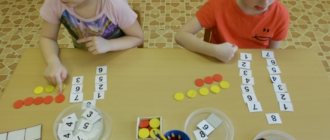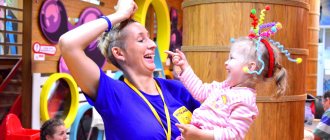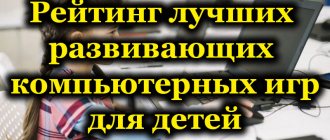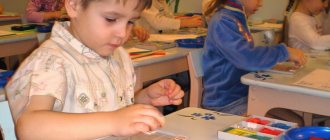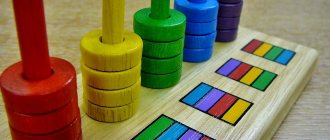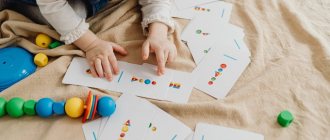For the development of a harmonious personality, mathematics classes for children will be very useful, which can be started from 3-4 years old - it is at this age that children begin to develop their first mathematical concepts. Do not forget that preschoolers should be taught through play, using dolls, pictures, unusual methods and techniques to maintain interest - this is the only way the effect will be maximum, knowledge will be stored in the head for a long time, and the child will not lose interest in the process.
Tips for parents
To make math classes not only useful, but also interesting and fun, you should adhere to the following recommendations:
- Act according to the principle “from simple to complex”: first offer the child those tasks that he can cope with, do not rush, work through the material in detail and do not take on new things while there are gaps in the old. You should not compare your child with other children, because everyone’s development follows an individual path, and what is understandable to one child may be very difficult for another. This is important to consider.
- Parental praise is a powerful motivation and should always be used, even if the successes are not impressive. You can at least praise your efforts.
- Of the two options - to hammer useful material into the child’s head at any cost or to instill in him curiosity and a desire to learn - without a doubt, you need to choose the second. Over time, the child will remember numbers, quantities, and learn to navigate in space, but if he loses interest in the process, then it will not be easy to regain it.
- Correct choice of task. The secret of success is to give the child a moment of small discovery, so tasks need to be selected so that he can cope. Success will help you gain and strengthen self-confidence.
You shouldn't push your baby. If he uses his fingers when learning to count, it’s okay. Very often, those children who have already learned to count orally test themselves in this way. Over time, they will gain self-confidence and will not use their fingers.
About counting on fingers
At the first stage of learning to count on fingers, you need to firmly grasp all possible combinations. The child should not think about the answer within one hand.
Patriotic education of preschool children
Attentiveness and memory develop, including tactile memory, because counting takes place in the head. You have to hold several data in memory at the same time. A quick solution depends on intelligence and speed of perception.
Child counts on fingers
Before learning to count on fingers, the child is already familiar with the concepts of “more,” “less,” and “also.” Can count objects in order within five.
Further:
- You need to start with 1+1=2. Children put two fingers together and get 2.
- Then add another finger = 3.
- Add one more to three and get the fourth result (four).
- Add one more finger to four and get five.
Now you can master subtraction:
- Subtract one finger from five and it becomes four.
- Subtract one finger from four and it becomes three.
- If you take away one finger from three, there will be two left.
- Subtract one finger from two and one remains.
The lesson should not exceed 20 minutes. Children get tired quickly. You can diversify the lesson by changing activities - warming up, singing something, solving riddles, and so on.
Important! You can't force it. It is always easier to “lure” someone somewhere than to force them. Elements of play, competition and reward will do more and better than anything else.
Tasks and exercises by age
The simplest options for preschoolers 3–4 years old are games with fingers.
- Using your fingers, show the same number in different ways (for example, 5 is 4 and 1, 2 and 3, 5 and 0).
- It is necessary to bend several fingers, the child’s task is to name the exact number.
In addition to fingers, you can use other counting materials - buttons, sticks, pencils, shells - anything that is interesting to the baby.
Exercises at home
There are many interesting games that you can play at home with kids 3-4 years old. For example, circle a number. The mother prepares the material in advance - on a piece of paper she writes numbers familiar to the child in a chaotic order, then asks him to find all the twos and circle them. The task can be made more difficult by suggesting that you circle the twos in blue, the threes in green, and the ones in red.
Mathematics is not only counting, but also logic, so you can play the game “Make a bouquet” with your child. To do this, draw a blank: simple pots, from which three stems are visible. You also need to prepare a set of buttons in three colors in advance. Next, mom gives the task - to select “flowers” for each pot so that one of them must be blue or so that there are blue and red flowers next to each other in each pot. The task is also good because it trains fine motor skills.
You can come up with games yourself using available materials. For example, invite your child to make a caterpillar out of multi-colored buttons, using 3 red, 4 blue, 1 green buttons. So that the baby does not forget the combinations, you need to draw a square, paint it with the appropriate color, and write a number next to it. Using colored rectangles, you can make a train with carriages in the same way.
Many children love to draw and color; this can also be used during classes by offering kids coloring books with numbers (you can draw them yourself or use ready-made options). The essence of such drawings is simple: the child is given a picture that he needs to color in different colors. The image is divided into blocks marked with numbers, each of which has its own color.
At 3–4 years old, children need to be introduced to geometric shapes. The following tasks are suitable for this:
- The parent draws a series of shapes (circle - square - triangle - rectangle), then asks the child to show, for example, a circle.
- Further, the task becomes more complicated - you need to color the circle red, the square green, the triangle blue, and leave the rectangle white.
To prevent your child from getting bored, you can come up with a fairy tale about the magical world of figures who are in trouble. Only completing tasks correctly will help save them.
Outdoor games
Don’t think that math classes with a preschooler are something boring. If you get creative, you can have some fun. So, there are several fun and useful games:
- "One to four." The mother hums a song and then says a number from 1 to 4. As soon as it sounds, the child must take a certain position, touching the floor with the number of points indicated by the named number (for example, if it is 1, then you need to stand on one leg, if 2 - just stay standing on two legs, 3 – lean on your hand and both legs, 4 – on your arms and legs at the same time).
- "Meow-woof." The mother gives the instruction: the child must jump forward as many times as she says “meow”, and back as many times as she says “woof”. To perform this, the baby first counts his mother’s phrases, and then his own jumps.
You can do math with your little one on the street, asking him to count all the cats he meets on the way, or find the number 3 everywhere, or show him objects that are shaped like a circle. You can also ask your child to compare which car is bigger, what is next - a shop or a store, and give similar tasks.
Obtaining mathematical skills can and should be organized in a playful way. Only in this case will the child have fun and unnoticed remember the necessary material.
Didactic games for mathematical development
The presented card index of didactic games in mathematics is recommended for preschool teachers and parents. During classes, preschoolers become familiar with counting, learn to work with numbers and geometric shapes, compare, contrast, and list.
Objectives of the games presented in the catalog:
- gaining skill in using numbers;
- improving the ability to count and distribute numerical values;
- familiarity with numerical and conceptual designations of time, days, months;
- development of spatial and planar orientation, the ability to determine and explain the location of objects relative to each other;
- expansion of ideas about geometric shapes;
- development of memory, ability to think logically, reason, analyze, make assumptions, sum up, concentrate attention;
- development of creative thinking and imagination.
Didactic games in mathematics in the preparatory group
The preparatory group prepares preschoolers for entering school. Children already have a lot of knowledge, so games become more complex and provide the development of mathematical concepts sufficient for trouble-free learning in primary school.
Decorating the Christmas tree
The teacher attaches to the flannelgraph and also distributes to the pupils images of a Christmas tree and New Year's balls. He attaches 4 toys to the Christmas tree on the right side, 2 on the left. Children do the same with their Christmas trees. The teacher suggests adding up the balls: 4 + 2 = 6. Then he swaps the balls, it turns out 2 + 4 = 6. And so on several times with different numbers of toys. The game creates the idea that changing the terms does not change the sum.
Path for Little Red Riding Hood
Attached to the flannelgraph are images of grandma's house, Little Red Riding Hood, and forest trees. Under each tree is a simple arithmetic example that a preschooler can handle. The students take turns approaching the flannelgraph, solving an example, thereby moving Little Red Riding Hood closer to grandma’s house.
Yes or no
The teacher writes arithmetic examples on the board. Then shows the children pictures of numbers. If the number matches the solution to the next example, the children shout out: “Yes!” If the answer is wrong, they shout: “No!”
Make up a word
The game is competitive. The teacher displays arithmetic examples in two columns. Members of each team go out to solve them. The player who has solved the example approaches the table on which there are pictures of numbers corresponding to the solutions. He chooses his number, turns the picture over, and there is a letter there. Having solved all the examples, the team gets the floor. Those who complete the task faster win.
Didactic games in mathematics for the younger group
We present educational mathematical games that younger preschoolers can handle.
Find the figure
The teacher lays out 12 geometric shapes of different sizes and colors on the table in random order. He names an object with certain parameters, for example, a large green triangle, and the student must find this figure on the table and point at it with his finger.
Geometric shapes around
The game expands your understanding of basic geometric objects. For the lesson, you need to prepare images of figures known to preschoolers. The players’ task is to find things in the playing area that are similar in outline to the figures on display.
3 square
The game develops the skill of relating objects by size and consolidates the corresponding definitions in memory.
The teacher prepares 3 stacks of different sized squares. He takes 3 paper figures for himself, and distributes the remaining 3 pieces to the pupils. At the beginning of the game, the teacher one by one shows the squares to the children, while explaining the size of these figures: “This one is large, this one is medium, and this one is small.” Then he gives the commands: “Show me the smallest square. And now the big one. Show me the middle one." The children do it.
At the second stage of the game, the teacher tells that you can build a turret out of squares and shows how to do this. The large square should be at the bottom, the middle one is placed on it, and the small one becomes the top of the head. Pupils repeat after the teacher.
Treat the squirrels and bear cubs
The game teaches you to see whether groups of objects of different sizes are equal. Players develop the understanding that quantity is not determined by size.
The teacher places the toy animals in a row, explains that they supposedly came to visit, and first prepares images of forest treats: nuts for the squirrels, strawberries for the cubs. He asks the children if there are enough treats and asks how to find out. The players count how many toys came to visit and compare the quantities. Next, they give the animals a treat: they place the corresponding images next to them. If the number of treats turned out to be insufficient, children add as many as needed. If there are too many treats, the extra pictures are removed.
Call
The teacher arranges the counting sticks in two columns. One column should be larger in quantity than the other. The rest of the sticks are in the open box. The task is to use additional sticks to equalize the number of objects in the columns. After completing the task, the player must explain how he got this result.

